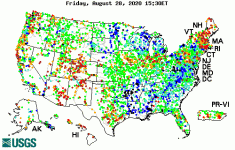And when disaster hits you'll be saying there was nothing that could have been done about it.
None of the predictions to date have come to pass. This leads me to doubt the latest cry of "Wolf."
Perhaps it is a slow-moving disaster which we would have plenty of time to react to.
The atmosphere is holding more water. Average dewpoints across the CONUS have increased a lot in the last 50 years. The frequency of occurrence of convective rain events that drop more than 2 inches of rain in one shot has increased by 50% or more over the eastern 2/3s of the CONUS. From 1930 to 2000 the median low temperature at the coastal site by my house for August was 73 degrees F. Record min was 62 and the record warm minimum was 81. 90% of the data were between 69 and 77. In the last 20 years the median has been 78. 50% of the observations have been above 78. In the prior 70 years only 10% of the observations were that high. In all of the last 10 years there has not been one single daily minimum temperature at this coastal site below 70 degrees F. That is over three hundred observations. It has also been quite common to not go below 80F for days on end. It was 84F here this morning which was a record warm minimum for the date. We've gone >10 consecutive years without setting a record cold temp in summer here while averaging dozens of record warm daily minimums. That isn't happening by random chance. The lower troposphere is a lot wetter in this neck of the woods, especially in summer when the Bermuda/Azores high is dominating our weather.
The distribution of the data has shifted. Some would say that the climate has changed. The water temperature is generally running 3-4 degrees warmer, the Atlantic high pressure is deeper and further west which suppresses our diurnal convection because of warmer temperatures in the mid and upper levels. That traps a massive amount of humidity at the surface. Yesterday at daybreak the temperature was 84F and the dewpoint was 81F. The 20th century average was 73F with dewpoint of 72F. Do you comprehend how much more heat is in a parcel of air with a dewpoint of 81 compared to 72 and what it takes to suppress that parcel from rising up and raining out? That humidity is what is getting advected up onto the continent to drive extreme rain events.

